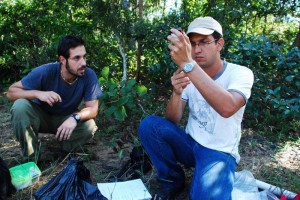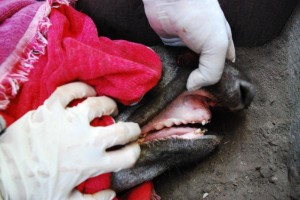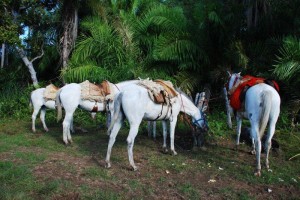Lowland Tapir Conservation Initiative
Ever since Olivia and Carter started OMG, they have been passionately looking for opportunities to help endangered species all over the world. Recently we came across an organization in South America who has the same passion and desire to help save animals from extinction. Carter and Olivia have been communicating with the folks at the Lowland Tapir Conservation Institute in São Paulo, Brazil. Their work is extraordinary and we just wanted to take a moment and share with everyone the amazing work they do. We hope you like their work and that you also learn something about the fascinating Tapir they work so hard to save.
The tapir is one of the first species in its habitat to be adversely affected by human disturbance. The new Lowland Tapir Status Survey and Conservation Action Plan developed during the Lowland Tapir Population and Habitat Viability Assessment (PHVA) Workshop held in Brazil in 2007 identified habitat destruction and fragmentation, with resulting population isolation, and intensive hunting as the main factors behind the decline of lowland tapir populations throughout their geographic range.
populations throughout their geographic range.
In 1996, Patrícia Medici started a long-term research and conservation program on lowland tapirs in the Atlantic Forests of the Pontal do Paranapanema Region, São Paulo, Brazil. In order to advance scientific knowledge and promote the conservation of this widely spread but seriously imperiled large mammal, Patrícia has launched a country-wide Lowland Tapir Conservation Initiative that will establish tapir research and conservation programs in other key biomes of Brazil. The first of these is a Tapir Research and Conservation Program in the Brazilian Pantanal, where no tapir research has ever been conducted. The next biomes where the initiative will be established in the near future are the Amazon and Cerrado. Tapir Programs in each biome will aim to benefit tapirs as well as a large number of other species and key habitats while having long-term positive impacts on the local communities.
 Tapirs: Keystone Species for Conservation
Tapirs: Keystone Species for Conservation
Ecological research of keystone species generates information to guide habitat conservation initiatives, as well as to promote education and local community participation. This will then lead to landscape conservation efforts that will ultimately influence decision- and policy-making. The research and conservation of keystone species can help design the necessary steps to safeguard a biome and influence policy-making. Tapirs are such a keystone species.
Conservation Status of Lowland Tapirs
The four living species of tapirs occur in the tropics of Central America (Baird’s tapir, Tapirus bairdii), South America (lowland tapir, Tapirus terrestris, and mountain tapir, Tapirus pinchaque), and Southeast Asia (Malayan tapir, Tapirus indicus). The lowland tapir has the broadest range of the four living species extending from north-central Colombia and east of the Andes throughout most of tropical South America down to north eastern Argentina and Paraguay at elevations up to 2,000 masl. The species occurs in 11 different countries including Argentina, Bolivia, Brazil, Colombia, Ecuador, Guyana, French Guyana, Paraguay, Peru, Suriname and Venezuela.

At the international level, the lowland tapir is currently listed by the International Union for the Conservation of Nature (IUCN) as “Vulnerable to Extinction” in the categories A2cde+3cde (IUCN/SSC Red List 2008; IUCN/SSC Global Mammal Assessment 2008). Additionally, lowland tapirs are listed in CITES Appendix II (CITES 2005), and as Endangered on the U.S. Fish & Wildlife Service list. In Brazil, although the species is not included in the national list of species threatened with extinction (Lista de Espécies Ameaçadas de Extinção 2003), the lowland tapir is reported in six out of seven state lists. In the states of Minas Gerais and Rio Grande do Sul, the species is listed as “Critically Endangered” and in the Paraná, São Paulo, Espírito Santo and Rio de Janeiro states it is included within the category “Endangered”.
six out of seven state lists. In the states of Minas Gerais and Rio Grande do Sul, the species is listed as “Critically Endangered” and in the Paraná, São Paulo, Espírito Santo and Rio de Janeiro states it is included within the category “Endangered”.
The tapir is one of the first species in its habitat to be adversely affected by human disturbance. The new Lowland Tapir Status Survey and Conservation Action Plan developed during the Lowland Tapir Population and Habitat Viability Assessment (PHVA) Workshop held in Brazil in 2007 identified habitat destruction and fragmentation, with resulting population isolation, and intensive hunting as the main factors behind the decline of lowland tapir populations throughout their geographic range.

Project History
In 1996, Patrícia Medici started a long-term research and conservation program on lowland tapirs in the Atlantic Forests of the Pontal do Paranapanema Region, São Paulo, Brazil. This program has included studies in ecology, population demography, epidemiology, genetics, habitat use and effects of habitat fragmentation, as well as promotion of community involvement, environmental education and habitat restoration efforts. One of the main achievements of the Atlantic Forest Tapir Program has been providing scientific information to restore critical tapir habitat (corridors and stepping-stones) identified through telemetry studies. Results of the project are currently being used to design a Regional Action Plan for Tapir Research and Conservation in the Atlantic Forest biome which will be implemented throughout the next years.
The Lowland Tapir Conservation Initiative
The Atlantic Forest Tapir Program has demonstrated that tapirs are a keystone species that play a critical role in
shaping and maintaining biological diversity and forest structure, and are essential for key ecological processes such as seed dispersal and predation. In order to advance scientific knowledge and promote the conservation of this widely spread but seriously imperiled large mammal, Patrícia has now launched a country-wide Lowland Tapir Conservation Initiative that will establish tapir research and conservation programs in other key biomes of Brazil. The first of these is a new Tapir Research and Conservation Program in the Brazilian, where no tapir research has ever been conducted. The Pantanal is increasingly threatened. Deforestation is now widespread throughout the region, threatening tapirs and other wildlife with local extinction.
Here is a great video from Jack Hanna highlighting the great work Patrícia and her team does to raise awareness about these endangered species;
Jack Hanna’s Into The Wild 2011 – Tapir Conservation Segment


